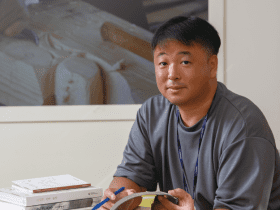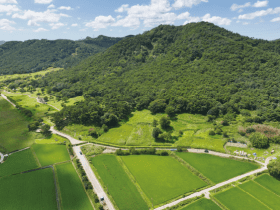“Research on the Shift in the Silla Capital Fortress System” is a comprehensive project encompassing archaeological excavations at the Wolseoung Palace site, interdisciplinary research, restoration efforts, and public outreach. This initiative aims to uncover the historical identity of the Silla royal capital and restore its capital fortress culture. Launched in 2015, the study includes archaeological excavations, literature analysis, paleoenvironmental investigations, architectural conservation and maintenance, public presentations of research findings, special exhibitions, and cultural heritage education outreach programs.
#1 Excavations Reveal the True Nature of the Wolseong Palace Site
Based on ground-penetrating radar (GPR) surveys, the scope of the excavation was divided into Areas A through D for phased excavation. The southern wall of Area A was constructed througha process of base preparation, central earthwork, and three to four rounds of earth accumulation. The remaining width of the outer wall is estimated to be about 36 meters, with a height of at least 9.8 meters when viewed from the depositional surface of the Namcheon River. The construction of the southern wall is believed to date back to the mid to late 4th century.The building cluster survey in Area C identified eight building features, four walls, one square feature, and one roof tile mound from the Unified Silla period cultural layer. Notably, the principal axis orientation of the building cluster varies by survey area. This suggests that the scale of the buildings and the design of the principal axis may be related to the function of the buildings, the timing of extensions andrenovations, and the overall spatial layout plan.


#2 Restoring the Paleoenvironment of Silla’s Royal Capital Through Interdisciplinary Research Researchers are developing a tree-ring data standard for wooden artifacts recovered from the Wolseong Palace site and surrounding sites. From 2018 to 2022, this chronology has been extended to span 149 years (307-455 CE), enabling absolute dating of wooden objects from 4th and 5th-century sites in the Gyeongju region to the exact year. Additionally, the team is exploring the potential for paleoclimate restoration using the standardized dendrochronology of the Gyeongju region. Future research will incorporate climate information studies using oxygen isotope dendrochronology.










#3 Wolseong Cultural Heritage Promotion and Education Outreach Connects Culture with Residents Since 2018, the project has organized “Daedam Silla” (meaning “sitting down in person and talking about stories of Silla”) four times annually. Since 2016, it has hosted “Wolseong, the Palace of Light,” an evening tour program at the Wolseong Fortress excavation site. The 2023 program includes (1) writing wishes on paper boats and floating them in Wolseong’s moat, (2) simulated excavation experiences at the Wolseong site, and (3) “Silla Maribgan’s Return to the Palace: Parade to Wolseong” and more.








Key achievements Academic PapersJANG Kimyeong, 2023, “The Sectional Construction Process of the Silla Wolseong Walls and the Fortress Construction Technology of the Royal Capital,” Ancient Korean History Journal 120
JANG Kimyeong, 2023, “The Construction Technology of the Earthen Fortress of Silla’s Royal Capital and Gaya’s Earthen Fortress,” Ancient Tombs in Gaya VIII – Gaya Tombs Research Collection
Academic Presentaitons
AHN Sohyun, 2023, “New Data on Archaeobotany from Ancient Capital Relics in Korea – Focusing on the Capital of Silla,”『熊本大学国際人文社会科学研究センター国 際 シ ン ポ ジ ウ ム 』.








